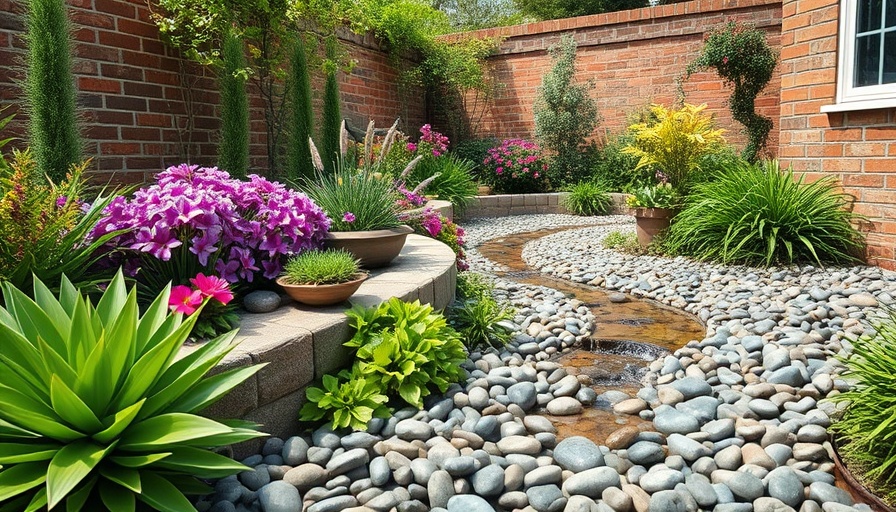
Understanding the Critical Role of Garden Drainage
For any home gardener or landscape enthusiast, mastering garden drainage is not just a technical requirement; it's the key to cultivating a vibrant and sustainable green space. Imagine your garden as a living ecosystem—one that thrives through the right balance of moisture and air. Without effective drainage, you might inadvertently create an environment conducive to root rot and stunted growth, undermining all your gardening efforts. In Maryland, where weather patterns can fluctuate and heavy rain is common, understanding these drainage dynamics becomes even more crucial.
Assessing Your Maryland Garden’s Unique Drainage Needs
The first step in ensuring optimal plant health is to evaluate the drainage capacities specific to your garden. A straightforward method to gauge this is through a percolation test. By digging a hole about one foot deep and filling it with water, you can observe how quickly the water drains. In a state like Maryland, where geographic variations are significant, it’s important to consider local soil types. Clay-heavy soils provide unique challenges, often necessitating further drainage solutions.
Choosing Plants Wisely: Matching Flora to Soil
Maryland's diverse climate supports a variety of plants, but understanding which species thrive under different drainage conditions can provide a powerful advantage. For instance, if you find that your soil tends to retain moisture, consider incorporating plants that flourish in wet conditions, such as ferns or certain types of sedges. On the other hand, drought-resistant plants such as lavender or succulents work well in well-drained areas. By researching local flora that suits your garden's drainage profile, you’ll create a sustainable ecosystem right in your backyard.
Enhancing Soil Structure: A Key to Draining Success
The health of your garden largely depends on the soil structure. Adding organic materials like compost or shredded leaves can improve water retention and promote better drainage. For those particularly struggling with heavy soils, mixing in sand or grit can facilitate aeration and allow for better water movement. Remember, soil health is a continuous journey, one that requires monitoring and adjustments to maintain its life-giving properties.
The Aesthetic and Functional Benefits of Raised Beds
When it comes to effective garden drainage in Maryland, raised beds do wonders. Not only do they offer an aesthetic appeal, but they also provide a practical solution for water management. By elevating your planting area, you can eliminate pooling around roots and encourage excess water to drain away effectively. Moreover, raised beds warm up quicker in the spring, allowing for an extended growing season—a boon for eager gardeners!
Implementing Robust Drainage Systems for Serious Issues
In cases of severe drainage challenges, it may be necessary to install dedicated drainage systems. Options such as French drains or gravel trenches can efficiently manage surface water and direct it away from vulnerable plant areas. However, understanding your property’s specific water flow dynamics is vital for choosing the most effective system. A well-designed drainage solution not only protects your plants but can also prevent potential soil erosion.
Maintenance Matters: Keeping Drainage Systems Functional
Even the best drainage systems require regular check-ups to ensure they stay in working condition. Pay attention to rainfall patterns and inspect your garden for standing water after storms. Maintaining soil structure by avoiding heavy foot traffic also plays a crucial role in preserving the garden’s ability to absorb water effectively. Keeping your drainage system well-maintained means a healthier garden overall.
The Role of Mulching: Benefits Beyond Aesthetics
Mulch serves as a multitasking superstar in garden maintenance—suppressing weeds, maintaining soil moisture, and importantly, enhancing drainage. By using organic mulch, you not only improve the appearance of your garden but also help retain an open soil structure that facilitates better water infiltration. As mulch breaks down, it enriches the soil while contributing to a healthier garden ecosystem.
Smart Strategies for Re-routing Excess Water
Preventing water accumulation is not just about managing what falls directly into your garden bed. Strategic placement of rain barrels and swales can help channel excess rainfall away, ensuring that your plants aren’t deluged during storms. These conservation techniques not only save water but also contribute to a sustainable gardening cycle that benefits both you and your plants.
Preparing for Extreme Weather: Staying Ahead of the Curve
As climate patterns evolve, gardens can experience more extremes—both in wet and dry spells. Preparing for potential flooding and drought involves a combination of robust drainage solutions and careful plant selection. By anticipating these changes, you can adjust your garden's design to thrive regardless of what Mother Nature brings.
Conclusion: Your Garden's Health Starts with Drainage
With the importance of garden drainage firmly established, every Maryland gardener can implement these actionable insights to foster a flourishing green space. Whether it’s adjusting soil composition, selecting appropriate plants, or taking advantage of innovative drainage systems, there is no shortage of strategies to ensure your garden thrives.
Ready to transform your garden? Start assessing your drainage today and take the necessary steps toward healthier, more productive gardening. Your plants will thank you!
 Add Row
Add Row 
 Add Element
Add Element 


Write A Comment